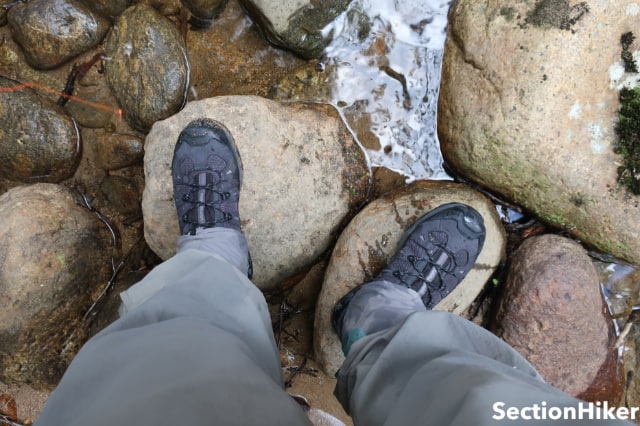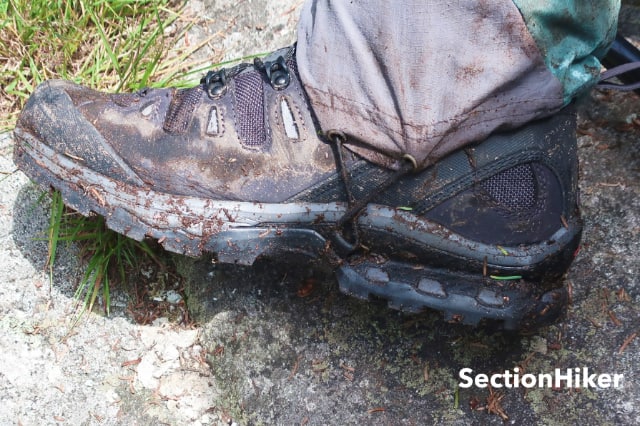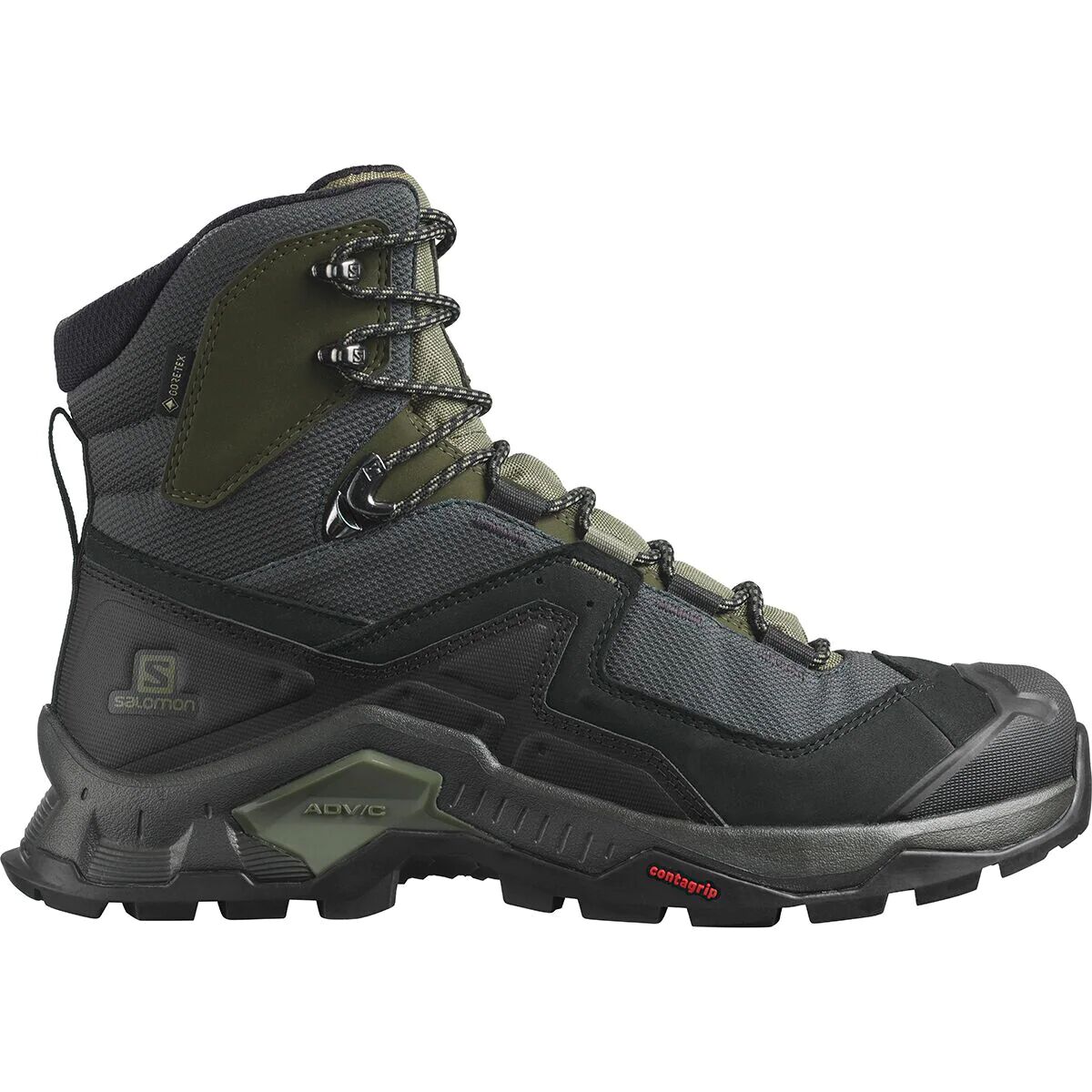
Salomon’s Quest 4D 3 GTX Hiking Boots blur the line between more traditional hiking boots and trail runners, combining the best attributes of both. They have a wide toe box with plenty of space to wiggle your toes, a beefy toe cap to protect them, and a stiff heel counter to resist pronation and dreaded ankle rolls. While they’re burly boots with excellent protection and traction, they’re surprisingly lightweight, they’re very flexible for high angle scrambling, and take very little time to break-in. I’ve worn a lot of hiking boots in my life, but these boots have exceeded all my expectations.
Specs at a Glance
- Gender: Men’s and Women’s sizes available
- Width: Regular
- Weight: 3 lbs/pair (men’s size 10.5/EU44 & 2/3)
- Type: Midweight
- Waterproofing: Gore-tex
- Ankle height: 8 inches
- Drop: 12 mm
- Best for: Day hiking, Backpacking
- Sizing: True to size
- Visit Salomon for more detailed specifications
I bought these boots because I wanted more ankle support after experiencing a serious ankle sprain while hiking in trail runners. While I expect to switch back to trail runners in the future, they don’t provide enough lateral support for me to resume hiking and prevent a recurrence of the injury at the moment. Believe me, I’ve tried.

I can’t speak to the claim that you can carry heavier loads with hiking boots than trail runners, but the 8″ high ankles on these Quest 4D boots prevent lateral ankle rolls much better than the low hiking shoes or trail runners I have used. That doesn’t mean that all hiking boots provide the same level of ankle-roll resistance, but these boots are off the charts in that regard. These Quest’s anti-roll capability has probably saved my summer hiking season, I’m so impressed by them.
The biggest advantage of trail runners over boots has more to do with drainage when they get wet and drying speed since all shoes lined with a waterproof/breathable layer take longer to dry. You can buy trail runners that don’t have a waterproof breathable liner but it’s very difficult to find real hiking boots and even mids without one.

While Salomon’s Quest 4D GTX is a burly hiking boot, it’s surprisingly lightweight and agile. Weightwise, the Quest 4D (in a men’s size 10.5) comes in at 1 lb 8 oz per boot (3 lb/pair) which is about 50% heavier than the trail runners I prefer. The weight difference is barely noticeable, for me at least, possibly because I hike for 6 months of the year, all winter, in insulated, waterproof/breathable hiking boots. These boots actually feel a lot like the Salomon XA Pro trail runners I’ve used in the past, which isn’t all that surprising really. They have the same flared heel for stability, good forefoot rocker (curvature) to reduce effort, and a stiff shank for midfoot protection.

The Quest 4D has a gusseted tongue to keep out trail debris and an asymmetric lacing system to match the curvature of your foot. There’s also a locking eyelet between the forefoot and ankle eyelets that is useful if you suffer from ankle lift. That locking eyelet also lets you create different “zones of tightness” in the lacing. For example, I prefer tight lacing from the ankle down to my toes, but a looser fit around the calf. You can achieve the same thing with different hiking boot lacing techniques but the locking eyelet makes it much easier to create.
The traction of the Salomon Contragrip soles is good on mud and wet granite, which we have an abundance of in New Hampshire, the Granite State (Vermont is the Mud State.) The edge of the outsole is stiff enough for edging on thin rock shelves when scrambling and grippy when hiking down steep rock faces. Their traction on wet rock is surprisingly good, providing a good balance between grip and durability. They also have an arch which helps with braking and allows compatibility with gaiters.

The Quest 4D GTX comes with Salomon’s standard insoles but does not provide much arch support, so I replaced mine with Superfeet Greens insoles which has a pronounced arch and a good heel cup to prevent the pronation that can lead to plantar fasciitis. (Oboz is the only hiking boot manufacturer that includes decent insoles in their boots and shoes.)
The one weakness of the Salomon Quest 4D GTX is the fact that it has a waterproof/breathable liner. This, coupled with the height of the ankle cuff, makes them warm to wear in hot weather. They also take over a day to dry if water comes in over the top of the ankle collar and soaks them. I haven’t worn them enough to break down the Gore-tex liner, but that’s just a matter of time. You can extend the waterproofness of any boot with a waterproof/breathable liner by applying ShoeGoo or Aquaseal to all the seams on the boot to seal them. That said, I didn’t buy these boots to keep my feet dry: I bought them because they provide lots of ankle support and to help prevent reinjury to my recently sprained ankle. The fact that they’re so lightweight and flexible, like trail runners, is a pleasant surprise.

Recommendation
Salomon’s Quest 4D GTX hiking boots are lightweight and agile hiking boots that provide a surprising amount of support and stability for hiking through rough and rocky terrain. They’re unique in that they combine the agility and lightweight of trail runners with the support and stability of a burly hiking boot. If you prefer hiking boots but want to switch to a pair that is lighter weight and requires little break-in, I can recommend the Quest 4D GTX. While it has the appearance of a waterproof/breathable hiking boot, it clearly has the DNA of Salomon’s trail running shoes. Highly recommended.
Disclosure: The author purchased this product.
Compare 2 Prices
-

 Amazon USUsed $158.02
Amazon USUsed $158.02$180.00$144.82ViewAmazon.com Price: $144.82 (as of 04/19/2024 09:24 GMT-0400) Details
Product prices and availability are accurate as of the date/time indicated and are subject to change. Any price and availability information displayed on Amazon.com at the time of purchase will apply to the purchase of this product.
-

 Backcountry.com$189.95View
Backcountry.com$189.95View
 SectionHiker.com Backpacking Gear Reviews and FAQs
SectionHiker.com Backpacking Gear Reviews and FAQs
Mine and a few friends favorite boots. The only negative is that they all seem to leak eventually.
A property shared by all waterproof breathable boots. Just seam seal them. No different than with leather boots.
Quests seem to be extraordinarily bad in this regard. I have used three or four pairs, and none has lasted more than two seasons, with a very moderate number of hiking days. Some pairs were replaced under warranty, though. (I am careful with my gear, so it is not a problem with dirt in shoes or sharp toenails.)
In fact, the frustration with Quests pushed me to trail runners. It was maddening to have a boots that fit me very well, only to have them let water in on every other major hike…
Great write up, for my money though I prefer the X Ultra 3. You get similar ankle support, the same waterproof liner, and they weigh in at just 1lb 15 oz for the pair. Price is also much more reasonable imo at just 165 USD. I’ve abused mine for over 5 years now and they’re still going strong.
Rob, I love my X Ultra 3 mids too, but after rolling an ankle in my trail runners the mid didn’t offer enough ankle support – so I got the Quest 4Ds & there is a significant difference. Yes, heavier, but more supportive – if that’s what one needs. Only day hiked with them so far, and will be putting my green superfeet in them as Philip suggests before first backpacking trip around Art Leob mid-September.
X Ultra Trek GTX is full height hiking boot as quest…
I have the 2-series of these, purchased in 2016. I can’t think *that* much has changed between interations – these are phenomenal boots, especially if you have bad ankles. I’ve had issues with sprains/rolling since I was a kid (once you have enough of these injuries your ankles’ ligaments are pretty much shot, which is where I’m at at age 38). My only gripes would be the grip/traction of the soles (maybe that has changed?), and – as you mentioned – the breatheability/dry times (which is kind of expected).
I took my pair up Elk Mountain in Oklahoma last January. They were very grippy on the granite at the top.
There is a non Gore-Tex version of this boot available from Salomon’s military Forces line of footwear. They do not appear to have any drain holes so would likely be of little advantage for creek crossing. If you suffer from hot feet, they should be more comfortable. I have only owned the GTX version so can not say with certainty. I would also recommend the Salomon Forces Mid which I purchased assuming they would be a nearly identical version of the X Ultra Mid, but they are much more rigid and supportive with the feel of the Quest 4d but the weight of the X Ultra Mid.
Great to hear that info Evan. Thank you so much for sharing. Can I order the mil boots on their website or should I call Salomon?
Cheers,
Bill in Roswell, GA
They can be ordered directly off of the Salomon website under the Forces collection. Many other tactical/law enforcement gear dealers also carry the Forces line.
https://www.salomon.com/en-us/shop/men/collection/forces.html
Excellent tip!
I prefer goretex lined boots all year. I have worn Lowa Renegades the last 8 years usually 1 new pair a year. I fixed the leaking goretex by switching AWAY form superfeet green. They rub the inner boot lining and ruin the goretex. I use PowerStep insoles that have softer undersides to prevent this problem. Read the Superfeet website and the “do not guarantee’ against superfeet ruining the goretex. 1200 miles on my most recently retired Renegades and they were still waterproof.
Didn’t know that! Thanks.
Nice review and very much in line with my experience. I wore Quest 4D on several Caminos (700 mile, 500 mile, and 450 mile) in Spain over the last several years because I knew that it would be impossible to find a size 14 Wide replacement boot in rural Spain. Yes, there were certainly times that they ran hot and dried slowly when wet, but at least I didn’t roll into Santiago with duct tape wrapped all around my boots like one of my walking companion.
Although my experience with Quests is that they started leaking even with the flimsy factory insole, but I managed to get a leak in my Lowas from using aftermarket insoles that rubbed the boot liner from the sides. I could actually see abrasion in the liner in the forefoot area. Similar abrasion is also visible in my Altra Lone Peaks where I use Superfeet Carbons, but it’s not a big issue as there is no membrane to break.
OK Philip, this article sounds like I wrote it! Though I wear the 3D version, it is outstanding. For most of my life I suffered ankle issues, having torn ligaments numerous times in my teens. Salomon Quest 3D with the Superfeet Green insoles feel as good on my feet as my 35 year old custom Limmers after a visit in NH with the man himself, Peter Sr. The Salomons grip even better on old, worn wet granite such as the Pressie Range which I reprised two summers ago. The Quest is my “go to” in our wet, mild cold southern mountain winters. The only trail shoe I’ve found that has the same feeling of “being planted” when worn is the Topo Terraventure (Altras don’t fit me as well and don’t hold up nearly as well as Salomon or Topo in my experience. After all these years why does Altra still have quality control issues? If you ever studied economics, you know why.). I still enjoy the Salomon X Ultra 3 but the toe box is a wee bit small for long hikes. When I hiked the Pressie Range with all of its rocky challenges wearing the Quest 3D, my feet never hurt at the end of the day. Few hikers in the huts could make such a claim! UL hikers prefer trail shoes of course, but when you need a waterproof boot (users should hold Goretex accountable if your Quests leak) that feels great, make the Quest your go-to boot.
Salomon foot shapes and my feet are not compatible. Merrill Wide fits me very well and on day 3 there is no toe squeezing/blistering as my feet spread out.
I really appreciate this review since I’ve been wearing their men’s XA Pro 3D V8 trail runner for several years, but have moved to steeper territory and am looking at getting back into a boot for longer trips. I have plantar faciitis in one foot and Salomon has really helped!! In fact, they’re worked so well that I bought an extra pair just for yard work and don’t have pain after long days mowing, squatting to weed, wheelbarrowing loads of pavers to lay a new patio, etc. (And though they don’t work for me now, I second your comment about Oboz insoles — I loved the two pair of low hikers I wore out before my feet changed. Aging is a pain. lol)
In case it helps anyone here, I *highly* recommend their phone reps if you’re looking for advice about which style to try; this was the first one they mentioned after asking lots of questions about my feet, and they know their stuff! Now off to snoop the details about this boot!
Hello sir before i buy a pair of shoes i wanna ask you . i am between two shoes lasportiva ultraraptor and salomon quest 3 gtx i am from turkey so i will use those shoes in lycian way which is a turquoise coastline trail 509km and very warm trail like 24° day 9°night at 8/11/2020 which shoe i should choose i have a very ultralight setup under 5.5 -4.7 kg but sometimes i need some ankle support .
Why don’t you just carry a lightweight ankle brace that’s compatible with the ultraraptors? You can put it on when you need it.